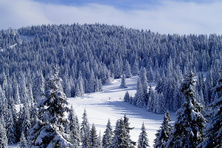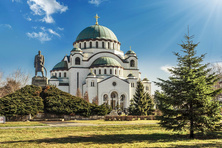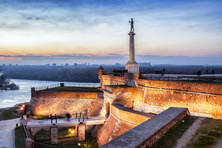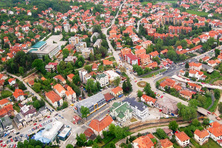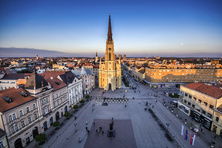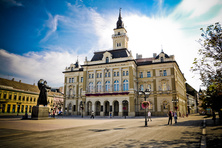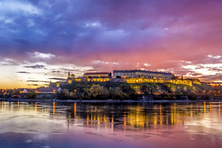Serbia
- Capital:Belgrade
- Currency: Serbian dinar
- Time: UTC+1, summer UTC+2
- Languages: Serbian
- Religions: Christianity (Orthodoxy, Catholicism)
- Sections: Get in Visa Customs Cuisine Money Details of interest Popular resorts
Serbia or officially the Republic of Serbia is a state on the southeast of the European continent on the Balkan Peninsula and Pannonian Plain. Serbia shares its border with the following neighbouring countries: Hungary, Romania, Bulgaria, Macedonia, Albania, Montenegro, Croatia, and Bosnia and Herzegovina.
Serbia has a temperate continental climate. Near the Adriatic sea the climate is Mediterranean. Summers on the north of the country are long and warm (the average temperature is +25°C) and short winter without much precipitations (the temperature is around +3°C). In the mountains on the southeast of the country the winter is colder and snowy (the temperature can reach -10°C) and summer is warm and without much rains (the temperature is around +23°C). The ideal period for visiting Serbia is from the end of April to the beginning of October.
The majority of the population are the Serbs. The dominant religion in Serbia is the Orthodox Christianity. The official language is Serbian.
Serbia mainly attracts the tourists who seek to improve their health on wellness resorts. The local wellness resorts Banja Koviljača, Vrnjačka Banja, Zlatibor, Niška Banja and Soko Banja are the best resorts in Europe offering good services for the attractive price.
Those who like old architecture should visit the city of Subotica in the province Vojvodina. A ski resort Kopaonik has everything you need for winter sports. In addition to unique microclimate, pure air and amazing landscapes, the travelers can take the advantage of the healing hot springs which are on the territory of the resort.
The capital of Serbia is Belgrade, the oldest European city and the best place to spend your holidays. Since its foundation in the 10th century, the city had been demolished dozens of times but it each time it revived like the Phoenix bird. The museums, luxurious palaces and castles preserve the history of Belgrade. There is a large sport and recreation center Ada Cingalija. The length of the beaches is 7 km. In Serbia, there is a high-quality sport infrastructure including everything you need for playing golf, tennis, football, volleyball and other sports. The fans of extreme sports will also be delighted as they can do bungee jumping, water skiing and paintball in Serbia.
Get in
By Plane
The most convenient way to get to Serbia is a flight. It will take you 3 hours to fly from Moscow to Belgrade. There are flights to Belgrade from the capitals of CIS and EU countries.
By Train
Travelers from Russia can reach Belgrade by a direct train from Moscow. Direct trains run from Greece, Croatia, Romania and Hungary. The tourists from the United Kingdom can also take a train to Serbia.
By Land
The European capitals and large cities of CIS have regular bus routes to Belgrade. You can get to Serbia by bus from Zagreb (Croatia), Skopje (Macedonia), Ljubljana (Slovenia), Budapest (Hungary), Istanbul (Turkey), Moscow (Russia), Kiev (Ukraine) and Minsk (Belarus).
By Ferry
A regular ferry route connects Italy and Montenegro and Serbia.
Visa
If the travelers from CIS countries are going to stay in Serbia less than 30 days, they do need to obtain a visa. A valid international passport is enough to cross the border. According to the migration-related legislation of Serbia, the tourists must have:
- funds (cash, credit cards, traveler's checks) 50 Euros per day for each traveler;
- personal travel insurance with the amount, at least, 20.000 Euros;
Border guard officers do not necessarily ask to submit all these documents.
The travelers from EU countries do not a permit to come to Serbia.
Customs
There are no restrictions for importing, exporting and declaring foreign currency but free export of any currency is limited to 2.000 Euros. The travelers can export from Serbia the sum over 2.000 Euros if it was mentioned in the import declaration.
The tourists can export the currency they cashed at Serbian banks from their accounts provided that they have the bank statement. It is prohibited to import and export Serbian Dinars if the sum exceeds 120.000 Dinars.
Travelers under the legal age can independently import personal belongings, cigarettes, alcohol and medications and medical devices for personal use.
It is not allowed to import to Serbia gold bullion bars and coins. The tourists can import to Serbia a sporting gun provided that they have a permit of the Hunting Association of Serbia.
The tourists can export antiquities, art objects and objects having a high historical value only with the permission of the local authorities.
Cuisine
As any other Balkan state, the Serbian cuisine was under a great influence of culinary traditions of Hungary, Germany, Turkey and the Slavic countries.
The cities of the central part of Serbia are known for their simple, substantial and very delicious meat and vegetable meals. The Serbs prefer mutton or pork. A specialty of the Serbian cuisine is the milk Kaymak, a fermented and salted product. The tourists are offered the Serbian sausages Ćevapčići, a traditional Serbian steak Vešalica and cured ham Pršuta. Pečenica is grilled meat with spices and herbs.
The local chefs like to use cheese as one of the main ingredients for their dishes. The most popular Serbian cheeses are Zlatibor and Senički. They are served as an appetizer and serve as an ingredient for many traditional dishes.
True Serbian meals cannot be imagined without bread which is a symbol of a good harvest. In addition to usual pastry, the Serbs also serve an authentic dish of a bread mash with cheese and warm milk Popara.
Vegetables are included in almost every dish in Serbia. The Serbs make vegetable salads and light vegetable snacks. We recommend trying a vegetable salad Srpska salata.
The Serbs like fish and you cannot leave Serbia without trying Riblja čorba, a fantastic fish soup. Alaska čorba is a hallmark dish of the province Vojvodina. This is a spicy fish stew.
Those who have a sweet tooth will enjoy a Serbian desert Salčići and cake with a cottage cheese Gibanica. In pastry shops, they sell Asian and fluffy European sweets. The deserts are typically served with a strong coffee, herbal drinks and juices.
The wine Vranac is the most popular wine in Serbia. The Serbs like a strong alcoholic drink Rakija (a moonshine with herbs, berries or fruits). A Serbian grape brandy has a very unusual taste. The Serbs also brew their own beer and Nikšićko beer is acknowledged the best.
Money
The national currency in the Republic is Serbian Dinar (RSD).
The tourists can exchange the currency at banks and in exchange offices. At the railway stations, airports and in large malls, there are the cash exchange machines from the licensed financial operators. The best exchange rates are for Euro, US dollar and pound sterling.
There are ATMs in all large Serbian cities. The ATMs in Belgrade and Novi Sad offer the lowest commission.
Stores, hotels and restaurants accept international credit cards Visa and MasterCard. You may face problems with Diners Club and American Express as they are not widely accepted.
Planning your trip to Serbia, be aware that it is not easy to cash traveler's checks there.
The tax-free system is available in Serbia and the tourists can refund 9-12% but in practice, only few stores work with this system.
Details of interest
Sightseeing in Serbia
UNESCO inscribed four Serbian sites to the World Heritage List. We highly recommend the tourists visiting these sites:
- The capital of Medieval Serbia was the city of Stari Ras. The monastery Sopoćani near the city is also under UNESCO protection.
- The men's Studenica Monastery with old frescoes dated the 13th - 14th centuries.
- The four Orthodox Monasteries on the territory of Kosovo: the Visoki Dečani, Gračanica, Pec Patriarchate Monastery, and the Church of Our Lady Ljeviš.
- A unique architectural complex of palaces Gamzigrad-Romuliana is a monument of the late period of the Roman Empire.
Around the historical monument the Belgrade Fortess there are a lot of sights such as the ruins of the Roman settlement the ruins of the Byzantine Castle, old churches, houses of the Roman Empire period and artillery platforms. In Belgrade, you will see the main Orthodox Cathedral of Saint Sava. Visit the four amazing palaces: the Royal Court and the White Court in the Belgrade suburb Dedinje and the New Court and the Old Court in the center of Belgrade. The Nikola Tesla Museum requires special mentioning as well as the Drvengrad Village which was built by a famous film director Emir Kusturica.
Niš city is a birthplace of Constantine the Great and there you can see ancient monasteries, Christian vaults and mausoleums.
The village Gornji Matejevac is an open-air museum of the Medieval architecture.
Serbian Souvenirs
Most often, the tourists buy in Serbia rakija and Opanci, handmade traditional peasant footwear.
The Serbian national hat šajkača is sold in any souvenir shop.
A small pouch with basil is a national Serbian averter which will protect you from misfortunes and hardships.
An expensive Serbian gift is Kolubara lace which is used to decorate clothes and home.









